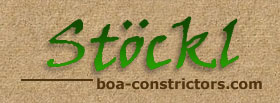Frequently Asked Questions
- Which boa is the best for a beginner?
- Hi, I have recently acquired a boa . Could you tell me how to take care of it and what I have to look out for?
- Is it possible to house Boas and Pythons together in one enclosure?
- My boa refuses to feed! What can I do?
- My little Suriname redtail Boa constrictor vomits the food. What can I do?
- Help! My Boa is very aggressive! How can I calm it?
- My boa escaped out of the vivarium. What can I do?
- I want to buy a boa but I already have other pets. Will they get along with the boas?
- Don't crossbreed boas also exist in the wild? So why must the boas in captivity be purebred?
- Here is a photo of my boa constrictor. Can you tell me whether it is a true one and from which distribution area it is?
- What is the life expectancy of a boa constrictor?
best boa for a beginner | Boa constrictor housing | Boa and Python in the same cage | Boa constrictor refuses to eat | Boa constrictor refuses food | Boa constrictor has regurgitated | how to tame an aggressive Boa constrictor | advice on agressive boa | snake escaped | boa escaped | Boa constrictor as pets | Boa constrictor and cats |
boa eats a small dog | boa eats a cat | boa and dog | boa constrictor life expectancy | boa constrictor life expectation | boa constrictor maximum age |
Which boa is the best for a beginner?
In our opinion and experience, the best boid (both boas and pythons) for a beginner is a Boa c. imperator.
Here are the reasons:
- They are robust in health
- They forgive the one or the other mistake in housing rather than other boids
- They are very good feeders
- They are relatively easy to breed
- They are hardly affected by the regurgitation syndrome
- They don't get all too big
- The boas we sell to beginners are docile
Of the available boas from our facility we particularly recommend the Hog Island Boas, the Corn Island Boas and the dwarfish bloodline of the Colombian boas.
The "sorts" mentioned above don't mind being handled and are ideal "pet-boas" for someone who likes to have a personal relationship with his/her reptile.
Hi, I have recently acquired a boa . Could you tell me how to take care of it and what I have to look out for?
Do you really expect us to e-mail you the text of our boa - book? Before acquiring any animal one should always get a book about the care and maintenance involved in keeping it.
We recommend our books "Ratgeber Abgottschlangen" and "Ihr Hobby - Boas und Pythons", both published by bede publishing company. We do not suggest these books in order to make money (we already got the money for these books), but because the care and maintenance of large snakes is described in them in detail.
If there may be special questions or problems that are not discussed in our books, we will certainly be glad to give you advice.
Is it possible to house Boas and Pythons together in one enclosure?
Almost all boas and pythons thrive in the same range of temperature and humidity. The average values during the day should be 60-65% humidity and a temperature of 28 Centigrade. At night we suggest 70-75% humidity and a temperature of 23 Centigrade. Housing at these conditions is ideal for most boas and pythons.
There are a few exceptions though, like tree pythons and emerald tree boas, which need a very moist environment.
Apart from these two species (and some others that we may have omitted), it is no problem to house boas and pythons in the same enclosure, assuming that they are of similar size.
Furthermore, they should get along with each other. This is easily determined, as they tend to lay together often if this is the case. Evading each other and urinating small amounts several times a day are signs that they do not do well together. In this case, housing them together would lead to permanent stress. This is not only valid for keeping boas and pythons together, but it is generally valid for snakes of the same species as well.
This was the physical side of the issue. However, there is another one, namely the question of style. In our opinion, housing boas and pythons in the same enclosure is lacking style, like a wedding in t-shirts and shorts.
My boa refuses to feed! What can I do?
Reasons for adult Boa c. to refuse feeding without being sick include the animal being in shed, gravid, or in the mood for mating (males only) during the breeding season.
Baby boas, juvenile or semi-adult animals should always feed, except when they are in shed. If such a boa refuses to feed (with the exception of a newborn baby, which has yet to start feeding) it is always a sign that something is wrong.
When the boa refuses to feed and all "normal" reasons (above) can be excluded, the first measure is to weigh the animal. This should be done weekly. If the weight stays constant and the boa shows a normal behavior otherwise, one can wait several weeks to see whether the animal will resume feeding.
If the weight drops noticeably, the snake is sick and other measures are necessary!
Most of the time, bacterial infections of the stomach/gut or the respiratory tract are responsible for the refusal to feed. Another reason can be that the animal is infested with internal parasites. Though this only occurs in wild-caught animals.
If the boa shows mucus in the mouth or groans while breathing, a bacterial infection of the respiratory tract is likely. If the excrements are foul smelling or diarrhea occurs, the stomach/gut is infested with bacteria or parasites.
But what shall one do if the boa shows no such signs.
To figure out the reason, one has to send a probe of the excrements to an institute (or bring it to a vet) for an examination. If no excrements are available, a probe with a culture swab must be taken from the gut and/or the mouth.
The institute (or the vet) will determine which bacteria are responsible for the infection and which antibiotic is effective (resistance test).
After the treatment with the effective antibiotic the boa should feed again.
Notice:
We cannot describe all reasons for non-feeding, but these are the most common ones
We assumed that all housing conditions are optimal
My little Suriname redtail Boa constrictor vomits the food. What can I do?
It is probably the Regurgitation Syndrome in Boa constrictor. The snake regurgitates (vomits) the prey item, generally between the 3rd and 5th day after feeding.
Notice:
The Regurgitation Syndrome is one of the most frequent causes of death in true redtail Boa constrictors!!! It is associated with a significant loss of water and minerals in the affected animal's body.
Mostly the snake keeper is responsible for the occurance of the Regurgitation syndrome due to wrong feeding!
Primarily affected:
... are neonates of redtail Boa c. constrictor such as true Surinames, Guyanas, Peruvians, and Brazilians, furthermore Boa c. amarali and Boa c. occidentalis.
Possible causes of the Regurgitation syndrome:
- Insufficiently developed digestive tract in neonates of the above mentioned subspecies
- Too large prey items and/ore too frequent feeding (the main reason!)
- Insufficient temperatures and humidity in the enclosure
- Internal parasites (wildcaught Boa constrictors)
- Bacterial infections of the stomach/intestine
- Nervousness because of handling or dominant specimen in the same enclosure
Measures on treating the "common" Regurgitation syndrome:
Definition:
The common Regurgitation Syndrome (that´s how I named it) is caused by feeding too large prey items and/or too frequent feeding or insufficient housing conditions. If there are other reasons for
regurgitation, it is NOT the common Regurgitation Syndrome.
Measures:
First check your housing: The day temperatures in the enclosure have to be between 28° and 30° Centigrade (82 to 86 degrees Fahrenheit), the night temperatures about 24° Centigrade (75 degrees Fahrenheit). The Humidity should not drop below 60%.
Furthermore:
- Do not feed for at least 14 days or longer (absolutely necessary)
- Next, start with a very (!) small prey item (pinky mouse for Boa neonates) and wait for at least 10 days before the next feeding (again with a very small prey item)
- Frequent feeding is always better than feeding large prey items
Notice:
If several regurgitations have occurred, the animals may be dehydrated and need injections of a sterile NaCl - solution subcutane. The quantity can be up to 4% of the bodyweight, injected every 2nd day until the water balance of the animal is OK again.
Measures to treat the uncommon Regurgitation syndrome:
Diagnosis:
Take a sample and send it to an institute for examination. A sample of the excrements is preferred, however, if not available, take a culture swab of the intestine (but notice: Parasites can not be found in a
culture swab).
Measures:
If the examination indicates a bacterial infection, a treatment with antibiotics becomes necessary. If parasites were found, use the suggested medicine.
If the reason for regurgitation is handling or housing with dominant specimen, you already know what you have to do...
But, no matter what the reason for the regurgitation is, the above described feeding regimen is always absolutely necessary!
My Boa is very aggressive! How can I calm it?
First of all, one should be aware that a Boa constrictor is not a pet, but a wild animal and a predator. Furthermore, one can never predict for 100 per cent how the animal will behave in the next moment.
But now to the question:
Take your boa out of the vivarium daily (except when it has fed or is in shed) and handle it for about 10 or 15 minutes. Use gloves in the beginning,and when it starts to be more docile try it without gloves. Sit down, put the Boa on your lap and jail it in your hands with gentle pressure. That way it can get used to your smell.
If the animal is so aggressive that it gets totally mad when you try tohandle it, you have to abstain from handling it. There is no other possibility than to come to terms with owning an aggressive specimen that is not going to calm down.
Notice:
The aggressions may be a sign that the animal is afraid. If you fear dogs to death, would it be helpful to force you to caress them? No!If your Boa doesn’t loose it’s aggressive behavior, take it as it is (a wild animal) and leave it alone as much as possible. You expect your partner to accept you like you are, do the same to the Boa.
We have several aggressive boas, including some very nice ones, that are honest and straight-forward in their behavior and we therefore always know what to expect when we handle them.
I think this is a good base for a partnership.
My boa escaped out of the cage. What can I do?
Any boid keeper of many years, who claims to have never had an animal escape, is lying through his or her teeth. The day comes for even the most conscientious among the boa or python keepers, when the sliding glass doors of the cage will not be entirely closed.
Ungrateful, as our charges are, they usually use this opportunity shamelessly and bolt. The smaller the snake is, the more difficult it then becomes to find it. The dear boid keeper that has never been faced with that type of situation before is usually overcome with panic, once he/she notices the escape of the animal.
However, that is exactly the wrong reaction, because it is now important to keep a cool head and use a systematic approach.
Before turning the house upside down, examine the enclosure thoroughly to make sure that the snake has not just hid very well.
A superficial glance onto the spots that the animal normally occupies is not sufficient in this case. You should really search every angle of the enclosure (this includes the ceiling), before expanding the search. In other words, you should search the enclosure in such detail that you would be confident enough to offer your right hand if the snake still ends up being found there.
Well, we now trust your search and believe that the snake is no longer in the enclosure. Next comes phase two, in which you have a great advantage: Boas and pythons do not usually travel far, and the animal will most likely still be in the same room, in which the enclosure is located. In addition, the snake maintains its normal behavior, which means that the fugitive has hid and is at a spot in the room that is suitable for providing shelter.
The less accessible and tighter this hide spot is, the more likely it is that you will find your legless friend there. If you think that you do not need to search a particular spot in the room, since “the snake would never be able to get there”, you have already made your next mistake.
Especially popular among escapees is the bundle of cables by the enclosure. They like to climb in it and rest in it as well. Another popular spot is the space between the enclosure and the room wall. If these objects just happen to have the permissible weight of a commercial truck, then you are pretty much out of luck, hence our recommendation in the section about enclosures to seal that space with construction foam or wooden strips.
If the entire room (except for the space mentioned) has been searched without success, the cabinet or enclosure needs to be moved. There is no way around that, as bad as it may be.
But we are not there just yet, as everything else comes first. It is recommended to move every removable object after thorough examination temporarily to another room for the duration of the systematic search. That way, the room in which the fugitive is suspected to be in, becomes more open and easier to manage. In addition, this prevents the animal from hiding in such an object later, if it is not found during the first day.
This brings us to the recommendation to keep the door to the enclosure room closed at all times. This applies especially if there is a “loose snake”.
A place beloved by the snake yet hated by the keeper is the interior of the living-room couch. The snakes even get in there, which is something that should be kept in mind, if the enclosure is located in the living-room. Also, remember to look behind the heater and between its heating ribs (if applicable).
In case of a partially open window, it pays to take a closer look at it and its immediate outside vicinity. Also, keep in mind that our legless friends are excellent climbers and love height, and the search should therefore include the top of shelves, cabinets, etc.
In conclusion of the “search & rescue manual”, here a few more hints:
It is much easier to search with a pocket light
If the animal is not found right away, keep on checking during the following nights, as that is the time at which the animal is most likely to crawl around somewhere
A daily inventory check to ensure the presence of all animals after maintenance work helps to discover an “escape” early, thereby raising the chance of finding the animal before it retreats to a place that is really difficult for the keeper to get access to (such as behind a cabinet, inside the couch)
When a snake has escaped, it is best to leave the enclosure door slightly opened (of course, this applies only as long as there aren’t any other snakes in the enclosure), which allows for your charge to return to its regular spot
During unsuitable climatic conditions, the room temperature should be adjusted accordingly (min. 23° C [73° F]), in order to prevent the snake from suffering while spending several days outside of its enclosure
Providing a bowl with water is also recommended if the animal was not successfully located right away
If the animal cannot be found in the enclosure room, the neighboring room has to be searched in the exact same manner, unless one wishes to abandon the search, and simply leave it up to chance
I want to buy a boa but I already have other pets. Will they get along with the boas?
No problem at all. We own a dog and a rabbit. Both often linger on in the living room where we have several cages with boas.
As long as the cages are locked (they always have to be, of course) there is no dangerous interaction between the boas and the other pets.
Notice: When you put the boas out for handling dogs, cats and other critters have to leave the room temporarily.
Although dogs and cats do not correspond to the prey pattern of Boa constrictor it doesn't hurt to wash the hands before handling the boa in case the pet has got some stroke units before, especially if your pet is a rabbit, a guinea pig or a tame rat.
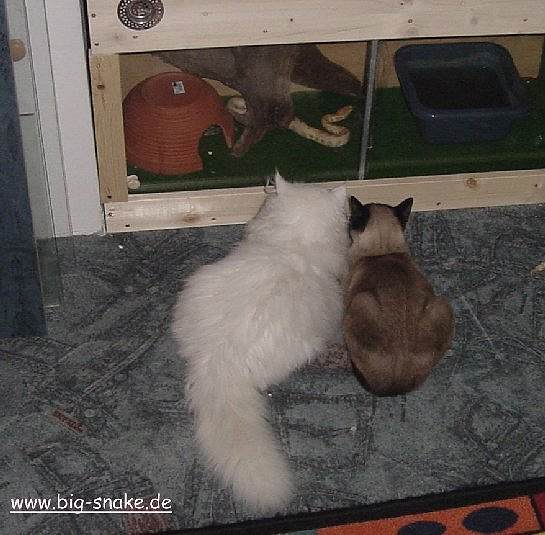 Cat Cinema Thank you to our friend Joachim Layer
Cat Cinema Thank you to our friend Joachim Layer
for the pic! His website www.big-snake.de is highly recommended
Don't crossbreed boas also exist in the wild? So why must the boas in captivity be purebred?
We have chosen the term "purebred" in context to Boa constrictor because it is brief and catchy. A more precise definition of our view is the term "unsophisticated wildlife form".
It is a fact that transitional forms of boas are found in locations where the distribution areas of two subspecies of boa constrictor are overlapping. However, these animals are also unsophisticated wildlife forms, because man wasn't involved in their emergence. Those animals evolved in the wild and their appearence is defined by local conditions.
These boas have nothing in common with the crossbreeds kept in captivity who evolved from the arbitrary crossing of boas from quite different regions.
Here is a photo of my boa constrictor. Can you tell me whether or not it is a true one and from which distribution area it is?
To determine the subspecies and variant of a boa constrictor from a photo is guesswork with little value since also crossbreed boa sometimes look quite identical to a purebred specimen.
Those who don't believe that it is heedless to take conclusions as to the lineage from the appearance should take a look at a photo (just google it) of Anna Ermakova, the extramarital daughter of Boris Becker. Would you assume when you look at Anna that her mother is a colored woman? Surely not.
The only safe method to ID a boa is to trace back the bloodline of the animal step by step (generation for generation) to the specimens that were caught in the wild (in their natural distribution area) and exported to your country.
To achieve this you need to ask the breeder or previous owner of your boa about the origin of the parents of the animal. Often it is necessary to contact the pre- previous owner or breeder, the pre- pre- previous owner and so on (please note that this is valid in both for the mother and the father of your boa).
That is, you need to re-trace the pedigree of your boa step by step including grandparents, great-grandparents and so on.
If you can’t trace back both lines to the distribution area (where the imported animals previously lived in the wild) because one of the former owners of the parents can’t be found or is not willing to give you information you can’t never be sure what kind of boa you actually have.
In most cases it will turn out that it is a crossbreed or that the land of origin can’t be determined anymore.
What is the life expectancy of a boa constrictor?
As a rule, a boa constrictor in captivity lives for about 20 years. However, there are exceptions: The record age of a boa constrictor kept in captivity was 40 years, three months and 14 days. This specimen was in captive care in the zoo of Philadelphia/U.S. (De Vosjoli 1998).
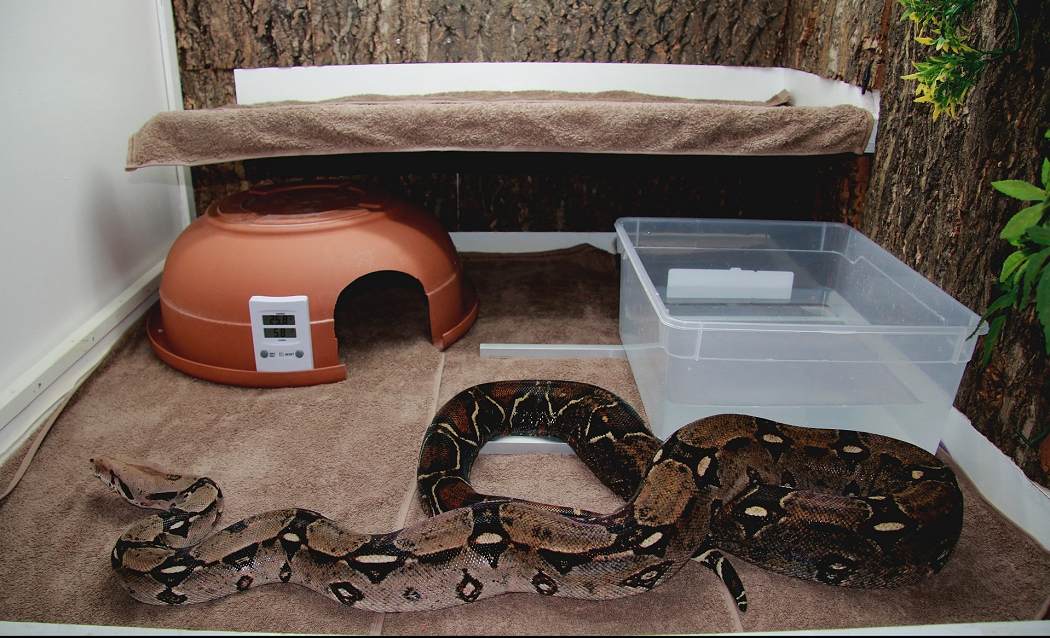 This crossbreed boa was born in 1996 and is still in perfect health. In 2014 she has had 25 babies. Photo: Peter Kahler
This crossbreed boa was born in 1996 and is still in perfect health. In 2014 she has had 25 babies. Photo: Peter Kahler
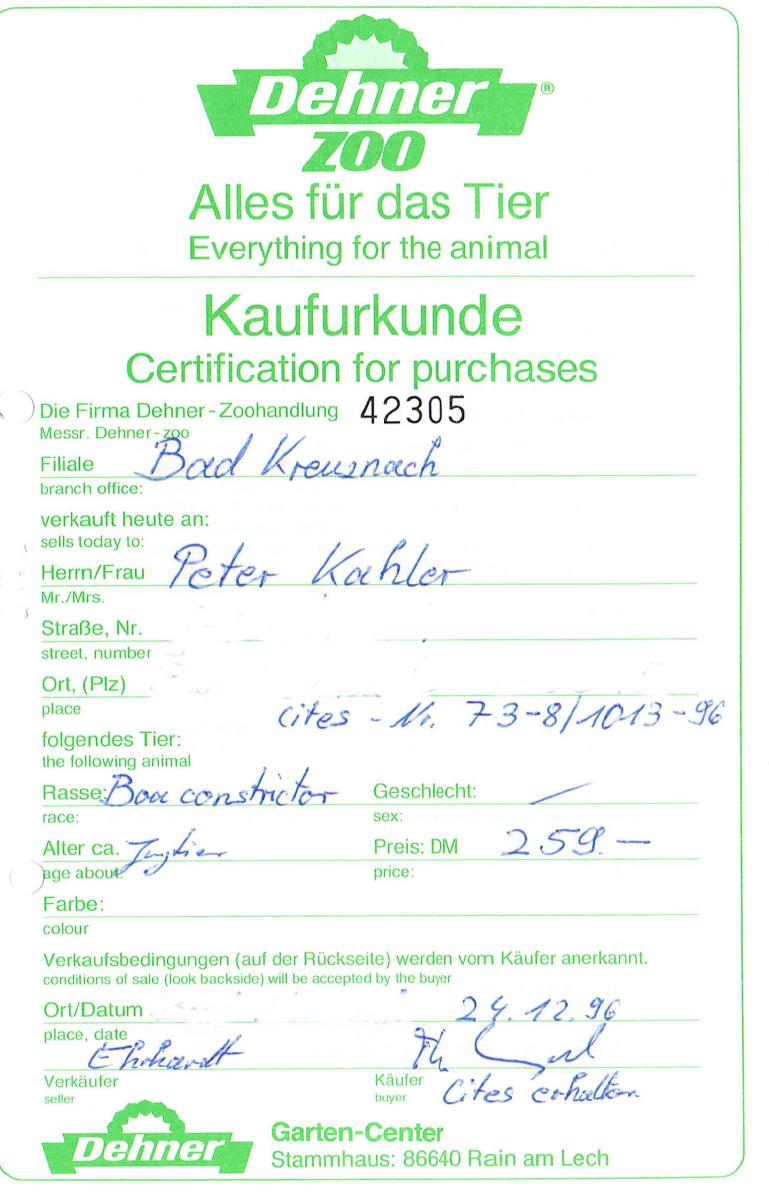 Invoice for the boa; Photo: Peter Kahler
Invoice for the boa; Photo: Peter Kahler
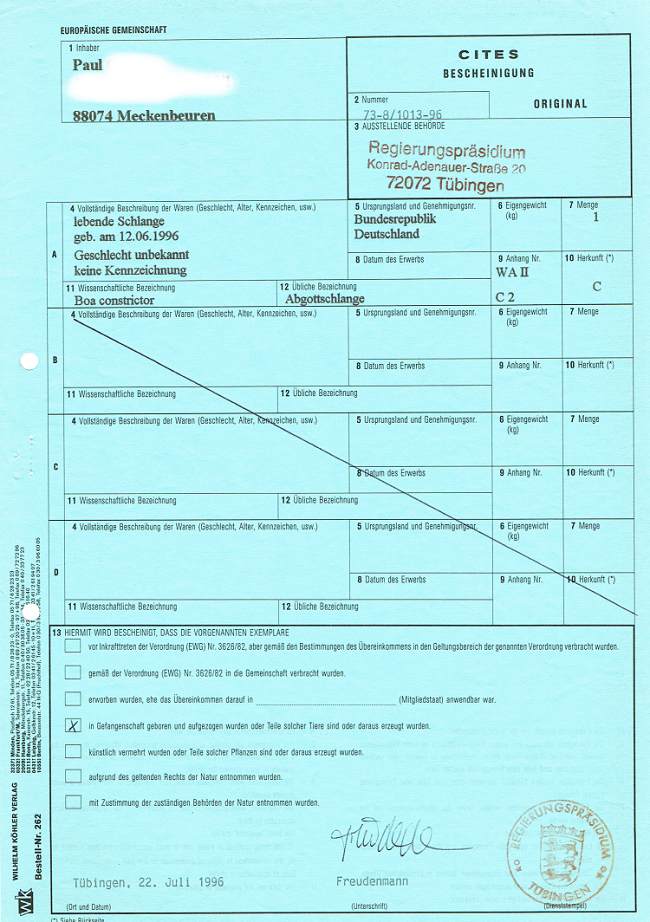 CITES - Certificate (at that time still mandatory); Photo: Peter Kahler
CITES - Certificate (at that time still mandatory); Photo: Peter Kahler
